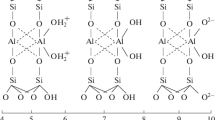Abstract
The major mechanism by which fulvic acid removed Cu2+ from Cu2+-montmorillonite was complexation, most likely chelation. This was confirmed by the use of a specific cupric ion electrode which showed that whereas the total Cu2 + concentration in the supernatant solutions increased with rise in pH, about 7 per cent of the total Cu2+ solubilized by fulvic acid occurred in the ‘free’ or ‘uncomplexed’ form at pH 2.5, only 0.6 per cent was similarly distributed at pH 4.5 and 0.0009 per cent at pH 6.5. External surface area measurements by a dynamic BET method showed the following surface areas: 2.5 m2g-1 for the fulvic acid, 8.0 m2 g-1 for the Cu2+-montmorillonite but 16.1 m2 g-1 for the FA-Cu2+-montmor-illonite complex. Electron micrographs of the FA-clay complex confirmed that fulvic acid was adsorbed in interlamellar spaces and on external surfaces of the Cu2+-montmorillonite.
Résumé
Le mécanisme principal par lequel l’acide fulvique extrait Cu2+ de la montmorillonite Cu2+ est la complexation ou plus probablement la chélation. Ceci a été confirmé par l’utilisation d’une électrode spécifique pour l’ion cuivrique; il a été montré que, alors que la concentration totale en Cu2+ dans les surnageants augmente avec le pH, environ 7 pour cent du Cu2+ total solubilisé par l’acide fulvique se présente sous forme ‘libre’ ou ‘non complexée’ à pH 2,5, 0,6 pour cent seulement à pH 4,5 et 0,0009 pour cent à pH 6,5. La mesure de la surface externe par une méthode BET dynamique donne les surfaces suivantes: 2,5 m2 g-1 pour l’acide fulvique, 8,0 m2 g-1 pour la montmorillonite Cu2+, mais 16,1 m2 g-1 pour le complexe montmorillonite Cu2+-FA. Les micrographies électroniques du complexe argile-FA confirment que l’acide fulvique est adsorbé dans les espaces interfeuillets et sur les surfaces externes de la montmorillonite Cu2+.
Kurzreferat
Als wichtigster Mechanismus, durch den Fulvosäuren Cu2+ aus Cu2+-Montmorillonit verdrängten, erwies sich Komplexbildung, sehr wahrscheinlich in Form der Chelatisierung. Dies wurde durch Verwendung einer spezifischen Kupferionenelektrode bestätigt, die zeigte, daß, während die Gesamt-Cu2+-Konzentration in der überstehenden Lösung mit Zunahme des pH-Wertes anstieg, etwa 7% des durch Fulvosäure in Lösung gebrachten Gesamt-Cu2+ bei pH 2,5 in ‘freier’ oder ‘niehtkomplexierter’ Form auftrat, nur 0,6% in ähnlicher Verteilung bei pH 4.5 und 0,0009% bei pH 6,5 vorlagen. Messungen der äußeren Oberflächen durch eine dynamische BET-Methode ergaben die folgenden Oberflächen: 2,5 m2 g-1 für die Fulvosäure, 8,0 m2 g-1 für den Cu2+-Montmorillonit, aber 16,1 m2 g-1 für den Fulvosäure-Cu2+-Montmorillonitkomplex. Elektronenmikroskopische Aufnahmen des Fulvo-säure-Tonkomplexes bestätigten, daß die Fulvosäure in den Zwischenschichten und an den äußeren Oberflächen des Cu2+-Montmorillonits adsorbiert wird.
Резюме
Главный механизм посредством которого фульвиновая кислота удаляет Сu2+ изСu2+-монтмориллонита является комплексообразование, повидимому, образование клешне-видной формы. Это подтвердили использованием специфического электрода из железа содер-жащего двухвалентную медь, который показал, что в то время как общая концентрация Сu2+ во всплывающих растворах поднималась при повышении рН, приблизительно 7% всего Сu2+, растворенного фульвиновой кислотой было при рН 2,5 в «свободной» или «неком-плексобразовавшейся» форме, при рН 4,5 только 6% было распределено таким же образом, а при рН 6,5 — 0,0009%. Измерения наружных площадей поверхностей динамическим методом ВЕТ показало: 2,5 м2/г для фульвиновой кислоты; 8,0 м2/г для Сu2+-монтмориллонита, но 16,1 м2/г для комплекса FА-Сu2+-монтмориллонита. Электронномикроскопические снимки комплексов РА-глины подтвердили, что фульвиновая кислота была адсорбирована в промежу- точных пространствах на наружных поверхностях Сu2+-монтмориллонита.
Similar content being viewed by others
References
Kodama, H. and Schnitzer, M. (1969) Thermal analysis of a fulvic acid-montmorillonite complex: Proc. Intern. Clay Conf., Tokyo 1, 765–774.
Schnitzer, M. and Hansen, E. H. (1970) Organo-metallic interactions in soils—8. An evaluation of methods for the determination of stability constants of metal-fulvic acid complexes: Soil Sci. 109, 333–340.
Schnitzer, M. and Kodama, H. (1972) Reactions between fulvic acid and Cu2+-montmorillonite: Clays and Clay Minerals 20, 359–367.
Winer, A. A. (1968) Modification of a low-cost Chromatograph to determine specific surface. Mineral Processing Division, Internal Report MPI (P) 68-31, Mines Branch, Canada Department of Energy, Mines and Resources.
Author information
Authors and Affiliations
Additional information
Contribution No. 467. Dedicated to the memory of Dr. W. F. Bradley.
Rights and permissions
About this article
Cite this article
Kodama, H., Schnitzer, M. Further Investigations on Fulvic Acid-Cu2+-Montmorillonite Interactions. Clays Clay Miner. 22, 107–110 (1974). https://doi.org/10.1346/CCMN.1974.0220115
Received:
Published:
Issue Date:
DOI: https://doi.org/10.1346/CCMN.1974.0220115




